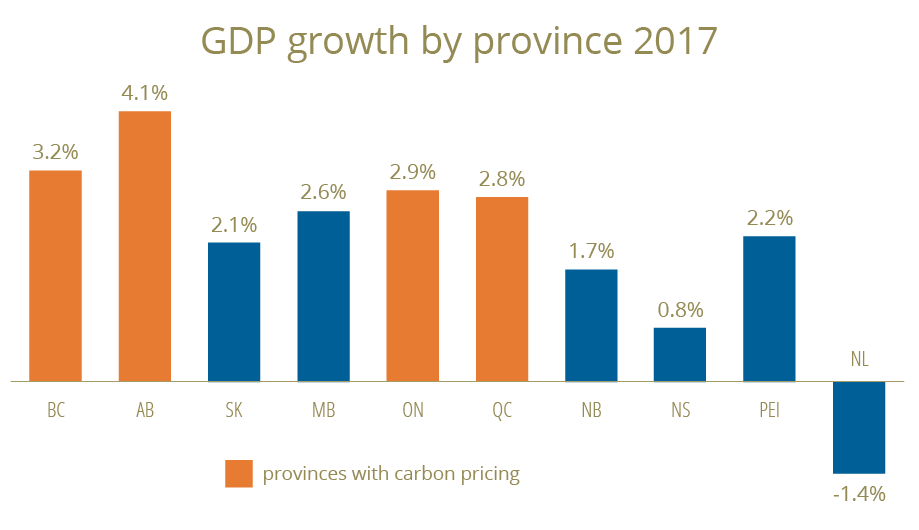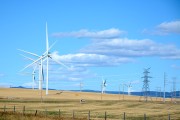Opponents of carbon pollution pricing have had a busy year, incessantly warning of the severe economic damage such policies will purportedly cause.
Thankfully, proponents of clean growth have had a busy year too. Alberta wrapped up its consultation process on output-based allocations for large industrial emitters, Manitoba and Nova Scotia announced new carbon pricing systems, and the federal government took steps to implement a pan-Canadian backstop for carbon pricing.
Beyond all the bluster, what does the evidence say about the relationship between economic performance and carbon pricing? As it turns out, we have a pretty good case study here in Canada.
In 2017, pricing carbon pollution became mainstream economic policy in Canada. Comprehensive carbon pricing systems are already in place in Canada’s four largest provinces, representing 86 per cent of the population. Ontario and Quebec have a cap-and-trade system linked to California, Alberta’s carbon levy increased from $20 per tonne to $30 per tonne on January 1, and British Columbia has a carbon tax at $30 per tonne (scheduled to increase to $35 per tonne in April).
In 2017, Canada led the G7 (a grouping of seven of the world’s largest advanced economies) in economic growth. It was our country’s best year for job gains since 2002. Unemployment is at a four-decade low. In short, it was a year of economic success for the country.
However, looking at Canada’s overall economy in reference to carbon pollution pricing is not totally instructive, as the country doesn’t yet have nationwide carbon pricing in place. (On January 1, 2019, a minimum carbon price of $20 will take effect in all provinces and territories.) How, then, did the four provinces that already have carbon-pricing systems sufficiently stringent to meet federal requirements fare economically?

In 2017, Quebec, Ontario, Alberta, and B.C. were the four best performing provinces, with 2.8 per cent, 2.9 per cent, 4.1 per cent, and 3.2 per cent in real GDP growth, respectively, according to preliminary numbers from RBC Economics Research. A before and after comparison is also possible. 2017 was the first year for Ontario’s cap-and-trade system and Alberta’s carbon levy; those provinces posted gains of 0.3 percentage points and 7.8 percentage points over the previous year’s growth.
While these figures do not indicate a causal relationship between carbon pollution pricing and outperforming economies, the data soundly refute the misconception that a carbon price hurts economic competitiveness and growth.
This shouldn’t come as a big surprise. We have known for close to a century — since economist Arthur Pigou’s work on externalities — that putting a price on pollution is the most efficient way to reduce it. Today’s economic literature agrees: carbon pricing does not result in decreased economic performance, and may even result in a “double dividend” — decreasing pollution while improving economic performance. The reasoning for this is simple: you put a price on something that you don’t want (pollution) and use the money for something that you do want (such as investments in productive and efficient infrastructure or lowering other distortionary taxes). Surely, these are sound fundamentals to build on.
This year, we look forward to carbon pollution pricing coming to all regions of Canada. Some progress was seen on this front just this week: the federal government published draft legislation to enable the pan-Canadian carbon price.
As carbon pricing is implemented, efforts should be made to ensure these systems do not result in adverse impacts to vulnerable, low-income, and rural Canadians. They must also maintain the competitiveness of Canada’s emissions-intensive and trade-exposed industries. (This is the small part of the economy with a credible argument that carbon pricing may, but not necessarily, impact its competitiveness with respect to jurisdictions that don’t act on climate change.) These principles are achievable with smart policy design, and will ensure that all Canadians benefit from the transition to a clean economy.
In short, the four provinces with an effective carbon pollution price outperformed the rest of the federation, and Canada led the G7 in economic growth. Acting on the climate challenge goes hand-in-hand with strong economic performance, and helps to future-proof our economy in the longer-term.
As evidence continues to mount in favour of pricing carbon pollution, what will the naysayers cite next?
Maximilian Kniewasser is the director of the B.C. Climate Policy Program, and Julia-Maria Becker is the director of the Clean Economy Program at the Pembina Institute, Canada’s leading clean energy think-tank.
This op-ed originally appeared in the Hill Times on January 17, 2018.








